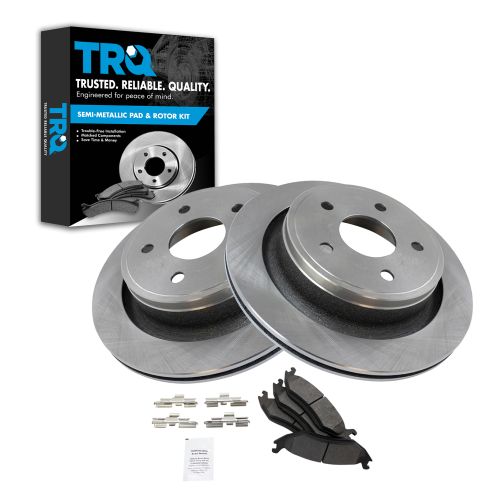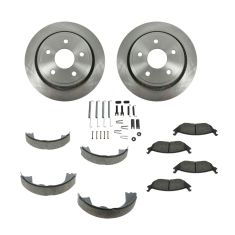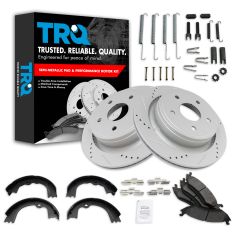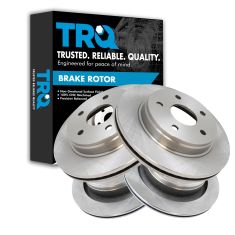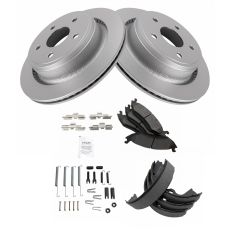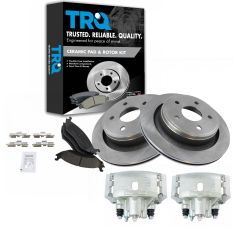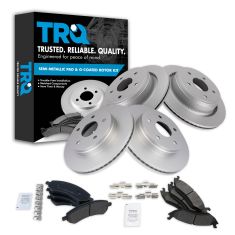Hi, I'm Mike from 1A Auto. We've been selling auto parts for over 30 years.
What's up guys? I'm Andy from 1A Auto. Today I'm going to show you how to do rear brakes on this 2016 Ram 1500. If you need these parts or other parts for your vehicle, click the link in the description and head over to 1AAuto.com.
We're going to loosen these lug nuts up. We're going to use a 7/8 socket. You can also use a 22 millimeter socket and a breaker bar. Just want to crack them free before we raise the vehicle. I'm going to raise and support the vehicle. We're using a two post lift. If you're doing this at your house, you can use a jack and jack stands.
I'll take these lug nuts off. We'll just use the socket. Take that last lug nut off. We can grab the tire, take it off. We're going to take this caliper off first. We're going to use a 10 millimeter socket and a ratchet. Take these two bolts out. Then we'll take those two out. Then I'm going to take a long straight head screwdriver, just get in here. I'm just going to pry in between the rotor and the caliper a little bit. Just to compress the piston a little bit. We can slide the caliper out. I'm going to use one of these caliper holders. We sell these at 1AAuto.com. Just slide it through here. It can hold the caliper right there. I'm going to take a straight blade screwdriver, get in between the pads, just slide these out. Take that pad off, and then take this one off. Do the same. Slide those brake pads out.
I'm going to take these two caliper bolts out. I'm going to use a 21 millimeter socket and a breaker bar. Break these free. Same with the top one. Now once I break those free, I'm going to switch to a ratchet, 21 millimeter socket and a ratchet. Loosen these up. Take those two bolts out and grab the bracket. Just slide it up.
Now when I go to take the rotor off, there is this little retainer that holds the rotor on. They just use this for the factory use when they're assembling the vehicle so the rotors don't fall off the axles. You don't have to reinstall it when you're putting the brakes back together. I'm just going to use some side cutters. Go in here, just grab this little tab, squeeze it, and then pry it out. It's going to break. Just slide it off. Throw it away.
Now to take this rotor off, it is rusted on there a little bit. I'm going to take a hammer. I'm just going to hit in these areas. Pop it off. Can rotate this a little bit. Give it a wiggle. It's still on pretty tight. Because we're replacing this rotor, I am going to hit it from the backside. There we go. Popped it loose. Just give it a wiggle, pull it off.
These are our old brakes. These our new brakes from 1AAuto.com. If you look at the pads, pads are the same shade, the ears are the same. The backing shield is the same. Material on the other side is the same. To look at the rotors, rotors are the same height, same thickness, same vented rotors. On the inside they have the drum for the parking brake assemblies. Get yours at 1AAuto.com and you'll be ready to rock and roll.
All right. Now we're going to clean up this brake caliper bracket. First I'm going to take a wire brush. Just going to clean up these pad slides. Just like that. Get some of the rust out. Take a screwdriver, get underneath here. Slide up on that, pull that out, clean up underneath. Get some more rust out and corrosion. Just like that. Can get a little bit on the back side of the pad slide, the pad clips. Take these and reinstall. Just get it lined up, push back down. We'll do the same with the other side.
Now on the brake caliber itself, these are set up a little bit different than normal. The caliper slides are attached to the caliper, so what we're going to do is we're just going to push these slides down, grab the rubber piece, push it all the way through, just like that. Take a little bit of that brake parts cleaner, spray it on there, use a rag, wipe it off, just like that. Clean that off. Take a little brake parts cleaner, spray down the whole of the caliber. Take the rag, get in there, dry it off. Clean that out.
I'm going to use some brake caliper grease. I'm actually going to slide it into the hole where the slide goes. That'll spread the grease around a little bit more. You could spread it on this as well, but just get it in there pretty good. We'll do the same for the other side. Take and install this. Sometimes it's a little tricky to get in. Just get that, push it through and make sure the rubber seal seals the same with that side. Then you can just take it and move it back and forth. Make sure it looks pretty good. We'll do the same for the other side.
Now before we put the rotor on, we're going to take a wire brush and just clean up some of the rust on this hub. I'm going to take the rotor, I'm just going to slide this on backwards first and then we're going to take some brake parts cleaner, spray it down. There is a protective coating on the rotor and you want to clean it off just to prevent the rotor from rusting. Flip it over, slide it on there, spray this side and wipe it down.
Before I push this on completely, just going to pull this off. There is this parking brake shoes right here. There's an adjuster underneath here. If you need to tighten it up, you can take a straight blade screwdriver, we can turn a little, it's a little star underneath here. You can go one way or the other if you have to tighten it or loosen it. Make a couple turns. There is a door on the back side so you can actually do this while the rotor's on. You can you take the little door out. See right here. Just grab a screwdriver, slide this rubber grommet out, just like that. Then you can get a smaller screwdriver or an actual spoon that will work for that. The spoon, what I mean by a spoon, I mean a brake adjuster spoon, not an actual spoon.
Now I can install the rotor. That feels pretty good. It's just dragging a little bit. You don't want it too tight. You can always loosen it up or tighten it up as you go. Take this little door, take this little grommet and install it. Just push it back in place. I'm going to take this caliper bracket, reinstall it. Use these bolts. There is some thread locker on these bolts. You can reapply thread locker if you'd like. Going to take my 21 millimeter socket and ratchet, tighten these bolts down.
Now I'm going to torque this with a torque wrench using a 21 millimeter socket to 132 foot pounds. I'm going to install the brake pads. I will just put a little grease, brake caliper grease on the ears. Then just a little bit on the back, just like that. Be careful not to get grease on the actual pad. Slide this into position. We'll do the same for the inside. Just like that.
I'm going to take this brake caliper hanger off. Set it aside. Take the brake caliper, flip it over, take one of the old brake pads, slide it into position there, and I'm going to use this brake caliper compressor tool. We actually sell this at 1AAuto.com. Slide this into position. You're going to have to loosen up the tool a little bit. All right, once you get that set, then I'm going to slowly compress this brake caliber, we're pushing the piston in. While we're pushing the piston in fluid's going through the hose, through the lines, back up to the master cylinder, into the reservoir. It's a good idea to check the reservoir after you're done the job and adjust the fluid accordingly.
Now we can remove the tool, the piston is all the way down. Take the caliper, make sure the the hose is not twisted. Slide this caliper back on here. For this caliper, actually goes up above here first. These slides, you may have to push these slides down a little bit. This caliper goes up like that then over. We can take these brake caliper bolts, slide those back into position, get those started and I'll take a 10 millimeter socket and a torque wrench and I'm going to torque these bolts to 24 foot pounds.
On the passenger side we had to go and install the caliper on the top. On the driver's side we want to install the caliper at the base first. This little notch out goes in first and then you slide the caliper down. If you're having trouble, that's probably why.
Take the wheel, line it up with the lug nuts. Take the lug nuts, get those started. Just take the socket, make sure these are all snug, I'm going to lower the vehicle and torque them. After we do a brake job, we want to make sure that we get back in the truck and we pump the brake pedal because there's going to be an air gap between the caliper piston and the brake pads. Just pump it slowly. Once you feel that the pedal is hard, then you're good to go.
After we're done, we want to make sure and check the brake fluid level. The level right now is at the max line. there's a max line here, min line there. You're going to want to adjust this level accordingly. If you have to add fluid, just take the cap off, add fluid. If you have to suck some out, just get it in between those two marks, preferably near the max line.
Thanks for watching. Visit us at 1AAuto.com for quality auto parts, fast and free shipping, and the best customer service in the industry.
